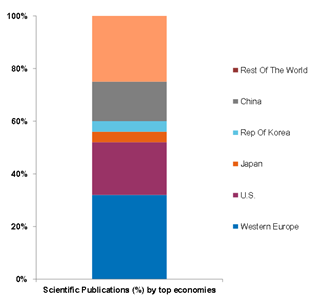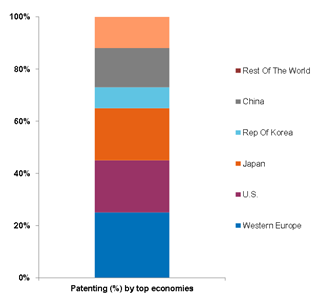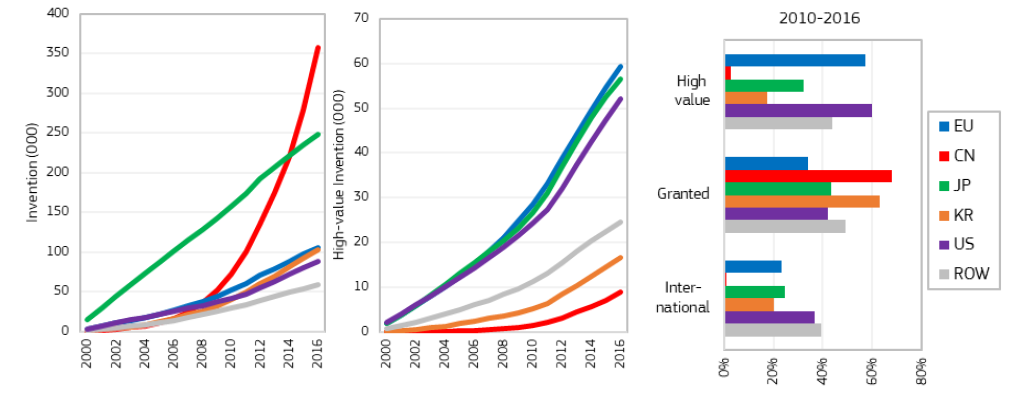Never before there has been an internationally-coordinated regulatory effort on a global scale around the issue of climate change. Regulation in this area is converging not only across the developed but also developing world, with China, for instance, unveiling an ambitious carbon-neutral agenda1.
For companies, this means that exposure to non-compliant areas of revenue generation will become more and more expensive. We believe that unique growth opportunities will come to those market participants that embrace change and take measures aiming to protect the environment, stall the pace of climate change and mitigate its impact. This will be very valuable in a world where areas of growth will be hard to find.
We see many exciting areas of innovation across a multitude of sectors but we find it particularly encouraging for investors that so many of them are linked to ESG. This is driven mainly by consumers and clients of different companies, who have their own goals and expectations related to ESG agenda. Regardless of their sector and area of activity, companies need innovative solutions to meet their objectives.
Europe and innovation
There is a big misconception and that is that Europe is not a global centre of innovation. In fact, as you can see in Figures 1 and 2, Europe is one of the world’s most innovative market based on the number of patents and scientific publications. According to World Intellectual Property Report, European scientists and engineers produce a third of all scientific research published globally.
Figure 1 EU: scientific publications by top economies

Figure 2 EU: Patenting by top economies

Source: World Intellectual Property Report and the European Commission, 2019.
Figure 3 Green inventions

Note: Cumulative trend of green inventions (left), high-value green inventions (centre), and share in the period of 2010-2016 of high-value, granted and international inventions (right) for major economies over their total number of green inventions. “High value” means that the invention is patented in at least two different regions of the world. Source: The 2020 EU Industrial R&D Investment Scoreboard, European Commission, JRC/DG R&I.
Moreover, Europe is closely second to the US in terms of high value “green” inventions (Figure 3), i.e. those ESG-related inventions that are patented in at least two different countries.
New green age: bacteria, steam and burpless cows
There are many examples of ESG innovation which are well-publicised and already familiar to most. For instance, in the area of greenhouse gas emission reductions, the automotive sector is working on transitioning electric vehicles to more efficient, and hence “greener”, semiconductors. Or construction companies using new materials and technology to insulate buildings better than ever before.
Some innovations are less intuitive and hence, often, are less known despite their potential future impact on decarbonising our future. In this category we find enzyme and microbiological solutions in many industrial processes. Enzymes are used to replace harsh chemicals, increase and accelerate performance of various products, and as the result, they save time, resources and energy for both clients and producers. For instance, enzymes are the key ingredient in the new greener detergents that work at lower temperatures and are produced without the use of oil derivatives. A global leader in this field, Novozymes, is engaged in a variety of exciting research projects, such as alternative sources of protein, including through fermentation or by using fungi.
Another example is a feed additive for cows that reduces methane production by their digestive system, by about 30%. According to the United Nations Economic Commission for Europe, methane is more than 80 times as potent as carbon dioxide in warming the atmosphere. It took about 10 years for the Dutch company DSM to develop a supplement which takes only a quarter of teaspoon a day to largely suppress the enzyme which triggers methane production by a cow. This product contributes to a significant and immediate reduction of the environmental footprint of beef and dairy products.
Spirax Sarco, a British company, developed innovative ways of efficient use of steam in industrial processes. The company comes up with tailored solutions for its clients. For example, working for a biscuit baker, they managed to capture the heat and steam produced by the ovens and use them in energy-intensive processes in other parts of the site. This type of solutions have helped to avoid wasting about 40% of energy and heat.
Large innovative companies tend to be global, which enables them to export their expertise and solutions around the world, be it to other companies in North America or Asia. One such example is Carl Zeiss Meditec AG, a German medical technology company specialising in innovative products to improve the diagnosis and treatment of diseases. The company found in Asia a very successful market for its solutions for cataract and other types of eye surgery to treat a range of age-related diseases. The company inaugurated its ZEISS Innovation Center for Research and Development in Shanghai in January 2012, with the aim to develop customer-tailored products for the Chinese market.
Key innovation drivers
ESG innovation has been supported by climate-related regulations for some time now but they will become even more important in the years to come. The long-anticipated COP 26 conference is expected to put innovation at the heart of the global battle against climate change. This is chiefly because it has become clear that governments have so far failed to deliver the change needed to meet Paris Agreement targets. This can only be turned around through the development of and investment in new innovative solutions across all types of energy-intensive industries, sectors and modes of transport.
Climate change is becoming an overarching theme linked to most other sustainability trends in innovation, such as resources and waste, demographic shifts, healthcare and even digitalisation. To take the last category as an example, digital tools will be indispensable in the creation of circular economies, radically reducing greenhouse gas emissions, promoting renewable energies and monitoring and protecting ecosystems2. As innovations accelerate the pathway to net zero and help achieve a just transition, investors will see many exciting opportunities profiting from the global attempt to build a more sustainable future for our world.
Important Disclosure
The opinions, analysis and views expressed in this publication are provided for information purposes only, it does not constitute an offer to buy or sell financial instruments, nor does it represent an investment recommendation or confirm any kind of transaction, except where expressly agreed. Although Candriam selects carefully the data and sources within this publication, errors or omissions cannot be excluded a priori. Candriam cannot be held liable for any direct or indirect losses as a result of the use of this publication. The intellectual property rights of Candriam must be respected at all times, contents of this publication may not be reproduced without prior written approval.
Candriam consistently recommends investors to consult via its website www.candriam.com the key information document, prospectus, and all other relevant information prior to investing in one of our funds, including the net asset value (“NAV) of the funds. This information is available either in English or in local languages for each country where the fund’s marketing is approved.
1 https://www.bloomberg.com/news/articles/2021-08-10/how-china-plans-to-become-carbon-neutral-by-2060-quicktake
